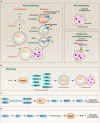Mitophagy in Pancreatic Cancer
- PMID: 33718171
- PMCID: PMC7953903
- DOI: 10.3389/fonc.2021.616079
Mitophagy in Pancreatic Cancer
Abstract
Pancreatic ductal adenocarcinoma (PDAC), one of the most aggressive solid malignancies, is characterized by the presence of oncogenic KRAS mutations, poor response to current therapies, prone to metastasis, and a low 5-year overall survival rate. Macroautophagy (herein referred to as autophagy) is a lysosome-dependent degradation system that forms a series of dynamic membrane structures to engulf, degrade, and recycle various cargoes, such as unused proteins, damaged organelles, and invading pathogens. Autophagy is usually upregulated in established cancers, but it plays a dual role in the regulation of the initiation and progression of PDAC. As a type of selective autophagy, mitophagy is a mitochondrial quality control mechanism that uses ubiquitin-dependent (e.g., the PINK1-PRKN pathway) and -independent (e.g., BNIP3L/NIX, FUNDC1, and BNIP3) pathways to regulate mitochondrial turnover and participate in the modulation of metabolism and cell death. Genetically engineered mouse models indicate that the loss of PINK1 or PRKN promotes, whereas the depletion of BNIP3L inhibits oncogenic KRAS-driven pancreatic tumorigenesis. Mitophagy also play a dual role in the regulation of the anticancer activity of certain cytotoxic agents (e.g., rocaglamide A, dichloroacetate, fisetin, and P. suffruticosa extracts) in PDAC cells or xenograft models. In this min-review, we summarize the latest advances in understanding the complex role of mitophagy in the occurrence and treatment of PDAC.
Keywords: PDAC - pancreatic ductal adenocarcinoma; autophagy; mitophagy; therapy; tumorigenesis.
Copyright © 2021 Xie, Liu, Kang and Tang.
Conflict of interest statement
The authors declare that the research was conducted in the absence of any commercial or financial relationships that could be construed as a potential conflict of interest.
Figures

Similar articles
-
Oncogenic KRAS Induces NIX-Mediated Mitophagy to Promote Pancreatic Cancer.Cancer Discov. 2019 Sep;9(9):1268-1287. doi: 10.1158/2159-8290.CD-18-1409. Epub 2019 Jul 1. Cancer Discov. 2019. PMID: 31263025 Free PMC article.
-
Mitophagy Receptors in Tumor Biology.Front Cell Dev Biol. 2020 Nov 11;8:594203. doi: 10.3389/fcell.2020.594203. eCollection 2020. Front Cell Dev Biol. 2020. PMID: 33262988 Free PMC article. Review.
-
BNIP3L/NIX and FUNDC1-mediated mitophagy is required for mitochondrial network remodeling during cardiac progenitor cell differentiation.Autophagy. 2019 Jul;15(7):1182-1198. doi: 10.1080/15548627.2019.1580095. Epub 2019 Feb 22. Autophagy. 2019. PMID: 30741592 Free PMC article.
-
Clearance of damaged mitochondria via mitophagy is important to the protective effect of ischemic preconditioning in kidneys.Autophagy. 2019 Dec;15(12):2142-2162. doi: 10.1080/15548627.2019.1615822. Epub 2019 May 22. Autophagy. 2019. PMID: 31066324 Free PMC article.
-
Controlling quality and amount of mitochondria by mitophagy: insights into the role of ubiquitination and deubiquitination.Biol Chem. 2016 Jul 1;397(7):637-47. doi: 10.1515/hsz-2016-0125. Biol Chem. 2016. PMID: 27145142 Review.
Cited by
-
The Role and Mechanism of Autophagy in Pancreatic Cancer: An Update Review.Cancer Manag Res. 2021 Nov 2;13:8231-8240. doi: 10.2147/CMAR.S328786. eCollection 2021. Cancer Manag Res. 2021. PMID: 34754243 Free PMC article. Review.
-
Mitophagy-mediated molecular subtypes depict the hallmarks of the tumour metabolism and guide precision chemotherapy in pancreatic adenocarcinoma.Front Cell Dev Biol. 2022 Jul 22;10:901207. doi: 10.3389/fcell.2022.901207. eCollection 2022. Front Cell Dev Biol. 2022. PMID: 35938160 Free PMC article.
-
Immune aging and infectious diseases.Chin Med J (Engl). 2024 Dec 20;137(24):3010-3049. doi: 10.1097/CM9.0000000000003410. Epub 2024 Dec 16. Chin Med J (Engl). 2024. PMID: 39679477 Free PMC article. Review.
-
Emerging mechanistic insights of selective autophagy in hepatic diseases.Front Pharmacol. 2023 Mar 16;14:1149809. doi: 10.3389/fphar.2023.1149809. eCollection 2023. Front Pharmacol. 2023. PMID: 37007026 Free PMC article. Review.
-
Case study of a neuroendocrine tumor of uncertain origin: single-cell transcriptomics unravels potential primary location.J Cancer Res Clin Oncol. 2024 Dec 31;151(1):28. doi: 10.1007/s00432-024-06071-z. J Cancer Res Clin Oncol. 2024. PMID: 39738894 Free PMC article.
References
Publication types
LinkOut - more resources
Full Text Sources
Other Literature Sources
Research Materials
Miscellaneous

